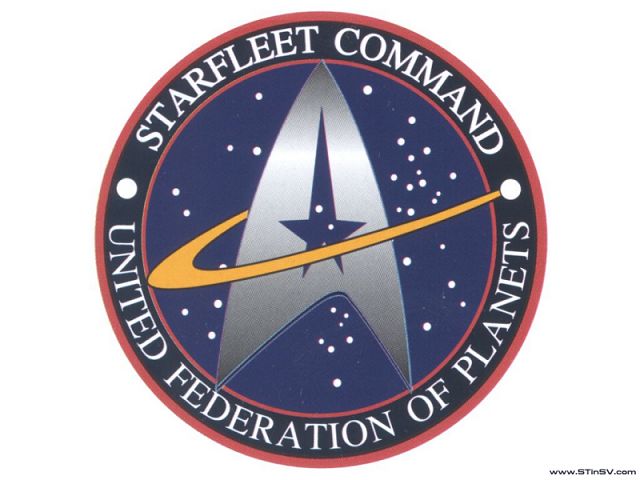 The
Science of Star Trek (pictures courtesy
of Star Trek in Sound and Vision http://www.stinsv.com/)
The
Science of Star Trek (pictures courtesy
of Star Trek in Sound and Vision http://www.stinsv.com/)
Author: David Allen Batchelor
Introduction
Is Star Trek really a science show, or just a lot of "gee, whiz"
nonsensical Sci-Fi? Could people really DO the fantastic things they do on the original
Star Trek and Next Generation programs, or is it all just hi-tech fantasy for people who
can't face reality? Will the real world come to resemble the world of unlimited power for
people to travel about the Galaxy in luxurious, gigantic ships, and meet exotic alien
beings as equals?
Well, as for the science in Star Trek, Gene Roddenberry and the writers of the show have
started with science we know and s-t-r-e-t-c-h-e-d it to fit a framework of amazing
inventions that support action-filled and entertaining stories. Roddenberry knew some
actual basic astronomy. He knew that space ships unable to go faster than light would take
decades to reach the stars, and that would be too boring for a one-hour show per week. So
he put warp drives into the show -- propulsion by distorting the space-time continuum that
Einstein conceived. With warp drive the ships could reach far stars in hours or days, and
the stories would fit human epic adventures, not stretch out for lifetimes. Roddenberry
tried to keep the stars realistically far, yet imagine human beings with the power to
reach them. Roddenberry and other writers added magic like the transporter and medical
miracles and the holodeck, but they put these in as equipment, as powerful tools built by
human engineers in a future of human progress. They uplifted our vision of what might be
possible, and that's one reason the shows have been so popular.
The writers of the show are not scientists, so they do sometimes get science details
wrong. For instance, there was a show in which Dr. Crus her and Mr. LaForge were forced to
let all of the air escape from the part of the ship they were in, so that a fire would be
extinguished. The doctor recommended holding one's breath to maintain consciousness as
long as possible in the vacuum, until the air was restored. But as underwater scuba divers
know, the lungs would rupture and very likely kill anyone who held his breath during such
a large decompression. The lungs can't take that much pressure, so people can only survive
in a vacuum if they DON'T try to hold their breath.
I could name other similar mistakes. I'm a physicist, and many of my colleagues watch Star
Trek. A few of them imagine some hypothetical, perfectly accurate science fiction TV
series, and discredit Star Trek because of some list of science errors or impossible
events in particular episodes. This is unfair. They will watch Shakespeare without a
complaint, and his plays wouldn't pass the same rigorous test. Accurate science is seldom
exciting and spectacular enough to base a weekly adventure TV show upon. Generally Star
Trek is pretty intelligently written and more faithful to science than any other science
fiction series ever shown on television. Star Trek also attracts and excites generations
of viewers about advanced science and engineering, and it's almost the only show that
depicts scientists and engineers positively, as role models. So let's forgive the show for
an occasional misconception in the service of an epic adventure.
So, what are the features of Star Trek that a person interested in science can enjoy
without guilt, and what features rightly tick off those persnickety critics? Well, many of
the star systems mentioned on the show, such as Wolf 359, really do exist. Usually,
though, the writers just make them up! There have also been some beautiful special effects
pictures of binary stars and solar flares which were astronomically accurate and
instructive. The best accuracy and worst stumbles can be found among the features of the
show that have becom e constant through all of the episodes. Here's a list of the standard
Star Trek features, roughly in order of increasing scientific incredibility:
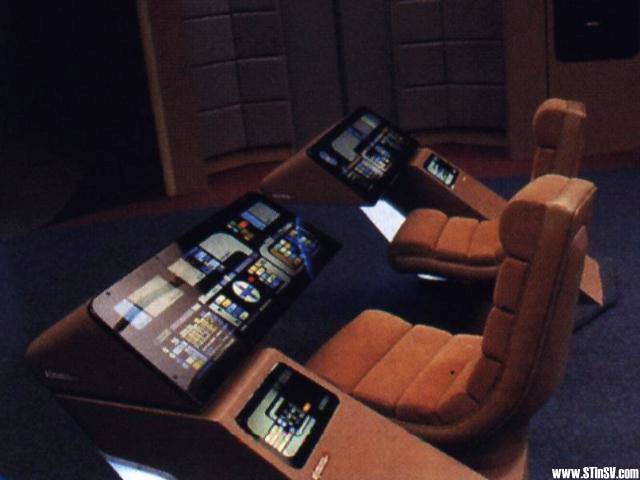 The Ship's Computer:
The Ship's Computer:
Most of the things it does are within the plausible realm of artificial intelligence that
computer scientists anticipate. We have auto-pilot functions and navigational systems
today, and these are the most used functions of the Enterprise computer. Our computers
even approach the ability to interpret spoken orders that the Enterprise computer has. In
400 more years -- the time when Star Trek: The Next Generation is set -- it is reasonable
to expect many of the abilities of this computer to really be achieved.
Matter-Antimatter Power Generation:
This is one of the best scientific features of Star Trek. The mixing of matter and
antimatter is almost certainly the most efficient kind of power source that a starship
could use, and the way it's described is reasonably correct -- the antimatter (frozen
anti-hydrogen) is handled with magnetic fields, and never allowed to touch normal matter,
or KA-BOOM! This much is real physics. Let's not bother about the dilithium crystals part
. . . sorry, but that's just imaginary.
Impulse Engines:
These are rocket engines based on the fusion reaction. We don't have the technology for
them yet, but they are within the bounds of real, possible future engineering.
 Androids:
Androids:
Well, an important research organization for robotics is the American Association for
Artificial Intelligence. At a recent conference on cybernetics, the president of the
Association was asked what is the ultimate goal of his field of technology. He replied,
"Lieutenant Commander Data." Creating Star Trek's Mr. Data would be a historic
feat of cybernetics, and right now it's very controversial in computer science whether it
can be done. Maybe a self-aware computer can be put into a human-sized body and convinced
to live sociably with us and our limitations. That's a long way ahead of our computer
technology, but maybe not impossible.
By the way, Mr. Data's "positronic" brain circuits are named for the circuits
that Dr. Isaac Asimov imagined for his fictional robots. Our doctors can use positrons to
make images of our brains or other organs, but there's no reason to expect that positrons
could make especially good artificial brains. Positrons are antimatter! Dr. Asimov just
made up a sophisticated-sounding prop, which he never expected people to take literally.
 Alien
Beings:
Alien
Beings:
Most scientists now agree that life probably exists in other solar systems, now that we
understand biochemistry a little. The chemical elements for carbon-based life like the
lifeforms on Earth are common in the Universe, so maybe lifeforms like ourselves are
numerous in the Galaxy. We can imagine all kinds of intelligent creatures, with any number
of arms, legs, eyes, or antennae -- maybe a lot smarter than we are. It seems doubtful
that humanoid shapes would be as common as the alien races on the Star Trek shows, though.
Well, we have to allow the show some concessions to the shapes of available actors. Could
half-human/half-alien hybrids ever exist, like Mr. Spock? It seems almost impossible, but
with recombinant DNA, our scientists have already created interspecies hybrids. Mr. Spock
is not totally beyond biochemical reality, but definitely at the edge.
Sensors & Tricorders:
We have vibration sensors, sonar, radar, laser ranging, various kinds of light wavelength
detectors and energetic particle detectors, and gravimeters. We also do a little
three-dimensional imaging of the interiors of solid objects, like the human body, with
magnetic fields and radioactivity detectors. The sensors and tricorders on Star Trek are
quite different and more revealing as plot devices than anything we have. But with a
stretch of the imagination, the tricorder scan could have today's magnetic resonance
imager as its ancestor. The Enterprise's sensors must use the more advanced (and
imaginary) "subspace fields," when it detects far-away objects in space, because
the crew never has to wait for signals to travel to a target and return. Not all of the
sensors on the show are possible.
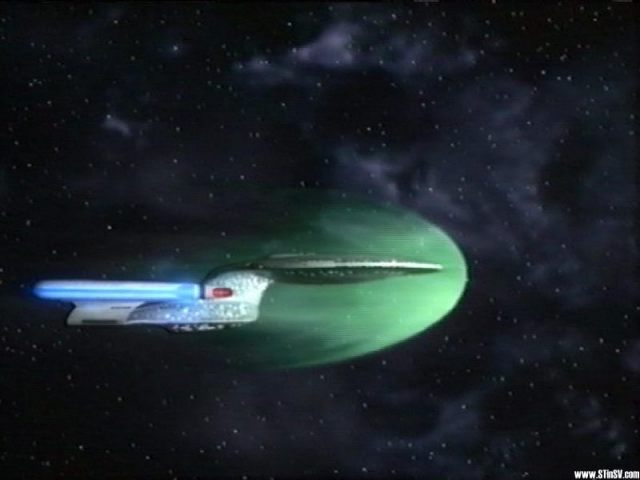 Deflector Shields, Tractor Beams & Artificial Gravity:
Deflector Shields, Tractor Beams & Artificial Gravity:
We know how to deflect electrically charged objects using electromagnetic fields, and
there are concepts for protecting space travelers from cosmic radiation this way. That's
the only phys ics trick we know that resembles the powerful special effects of the
Enterprise shields. We can also make big magnets that have some respectable attraction,
and with the right electronic circuits regulating the strength of the magnets, we can
imagine towing some kinds of metal objects through space. A beam that is projected at
something to attract it is purely imaginary. We don't have any way to create artificial
gravity either. Generating artificial graviton particles is imaginable, but there's no way
to say how it might be done.
Subspace Communications:
Mathematicians discovered the concept of a subspace within a space continuum decades ago,
and science fiction writers appropriated the term to serve their needs for a
super-advanced way to reach other points in space, time or "other" universes.
The concept is alive in physics today, in theories that our space-time may have eleven or
more dimensions -- three space dimensions and time, plus seven more that are "curled
up" within a tiny sub-atomic size scale, where they conveniently explain mysteries of
the forces of physics. But Star Trek uses its own unrelated version of subspace, with
signals that can travel as fast as the fastest starship. This is just a convenient notion
to get messages to Star Fleet and back by the end of a TV show, with no realistic physics
behind it.
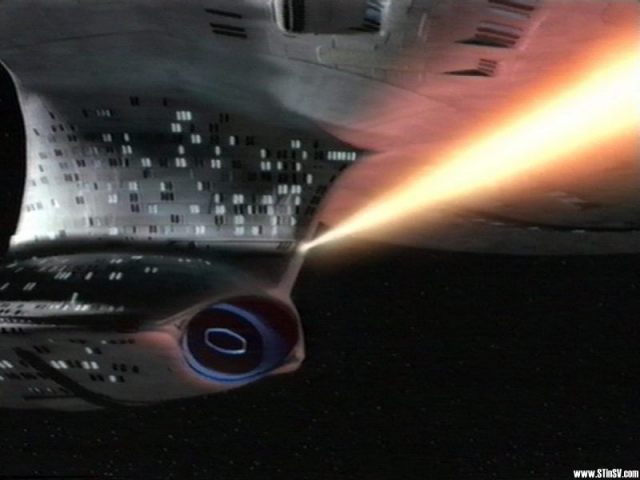 Phasers:
Phasers:
According to the Star Trek: The Next Generation Technical Manual, phasers are named for
PHASed Energy Rectification. They are really just spectacular energy blasters, with no
detailed physics explanation. The original concept was that they were the next
technological improvement upon LASERs. To the extent that they differ from LASERs, they
are just fanciful props, descended from generations of blasters in science fiction of
decades past.
Healing Rays:
Star Trek's Dr. Crusher shines a healing ray on her wounded patients and the skin or bone
heals immediately. That's just a magical medical miracle of the imaginary 24th century.
Surgeons today do work with lasers to cauterize or seal some tissues, and repair detached
retinas. Some dentists use them, too. Also, there is actually a form of adhesive that can
stick human cells together like Elmer's Glue (tm), and synthetic skin for temporarily
protecting wounds! But the body's own healing is usually as fast as any other method. On
the other hand, there is some evidence that weak electric currents can accelerate healing
of bones, so something similar to Dr. Crusher's procedure -- but not instantaneous -- may
become possible some day.
Replicator:
Today, we know how to create microchip circuits and experimental nanometer-scale objects
by "drawing" them on a surface with a beam of atoms. We can also suspend single
atoms or small numbers of atoms within a trap made of electromagnetic fields, and
experiment on them. That's as close as the replicator is to reality. Making solid matter
from a pattern as the replicator appears to do, is pretty far beyond present physics.
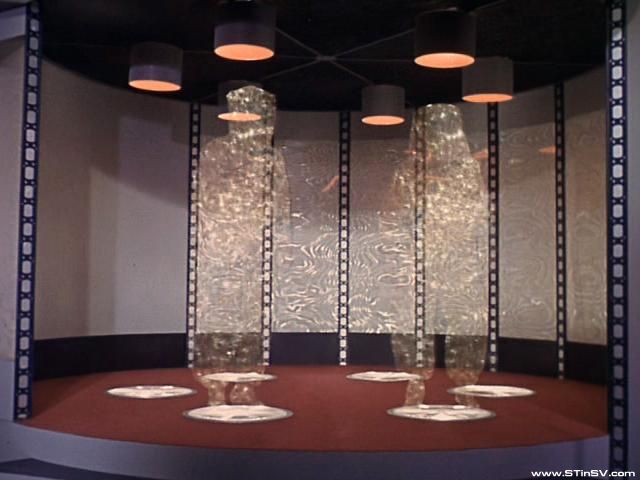 Transporter:
Transporter:
We don't have a clue about how to really build a device like the transporter. It uses a
beam that is radiated from point A to point B where it STOPS at just the right precise
place -- even passing through some barriers along the way -- and reconstructs the person
it carries on the spot. Or it captures a person's pattern, dematerializing him or her, and
brings the person to some other point. All of the rematerialized atoms and mol ecules are
somehow in the precisely correct positions, with the right temperatures and adhering
together just as if the transportee had not been dematerialized. Rematerializing, why
doesn't everything fall to pieces if a gust of wind or just normal gravity disturb the
reappearing atoms? Nothing in the physics of today gives a hint about how that might be
possible. Arthur C. Clarke said, "Any sufficiently advanced technology is
indistinguishable from magic." But we can't assume every magical feat could be
accomplished, given sufficiently advanced technology.
Holodeck:
The same applies to this one. Holograms are apparent images with three dimensional
structure. We can't imagine a way to assemble matter in the same way as the light in a
hologram.
Universal Language Translator:
As this is used on the Star Trek shows, it's just an automagical device to enable
characters to get through the stories. It would be too tedious and repetitious in a
one-hour show for the characters to overcome real language barriers in a realistic manner
in every show. The way the Enterprise crew can encounter an alien spacecraft, "hail
them on standard frequencies," and establish instant telecommunications on their
viewscreens is a preposterous shortcut to keep the plot from faltering. We can certainly
dismiss the possibility of such an invention ever being built.
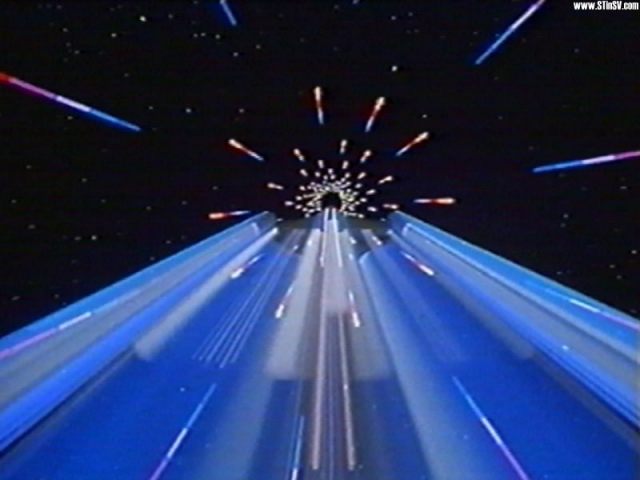 Warp
Interstellar Drive:
Warp
Interstellar Drive:
This must be the crowning achievement of Federation technology! Despite its fundamental
role in the show's plot, it violates known physics to an extent that can't be defended.
The detailed explanation of the warp field effect in the ST: TNG Technical Manual only
raises mo re questions than it resolves. It is said to involve huge discharges of energy
and subspace fields that aren't understood in today's science. However, barring a very
unlikely demolition of Einstein's theory by future, revolutionary discoveries in quantum
physics, warp drive can't exist. Physicists of today understand the space-time continuum
rather well, and there is very good reason to think that no object can move faster than
the speed of light. This doesn't stop scientists like the great expert on relativity and
quantum theory, Stephen Hawking, from enjoying the fun of the TV series, however.
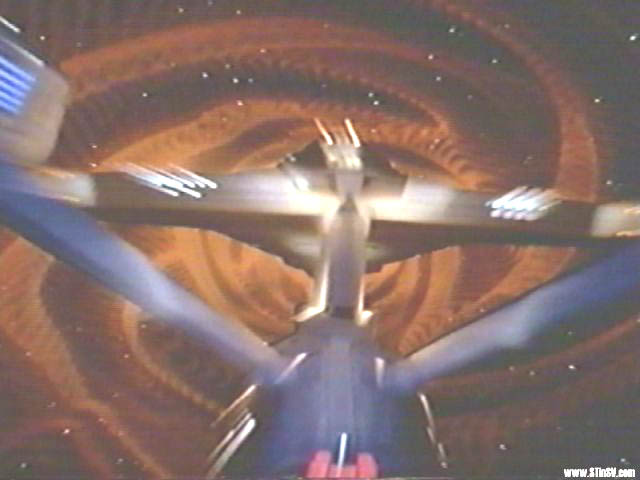 Wormhole Interstellar Travel & Time Travel:
Wormhole Interstellar Travel & Time Travel:
These are questionable consequences of some mathematical models for extremely bizarre,
artificial arrangements of titanic super-massive objects -- untested imaginary models
where Einstein's relativity theory is stretched to its ultimate limits. We don't have any
evidence that Einstein's theory is valid in these theoretical cases, and the arrangements
of these giant spinning masses don't occur in nature.
Conclusion:
So, the bottom line is: Star Trek science is an entertaining combination of real science,
imaginary science gathered from lots of earlier stories, and stuff the writers make up
week-by-week to give each new episode novelty. The real science is an effort to be
faithful to humanity's greatest achievements, and the fanciful science is the playing
field for a game that expands the mind as it entertains. The Star Trek series are the only
science fiction series crafted with such respect for real science and intelligent writing.
That's why it's the only science fiction series that many scientists watch regularly . . .
like me.
http://ssdoo.gsfc.nasa.gov/education/just_for_fun/startrek.html
copyright 1993 by David Allen Batchelor, Ph. D. (This article may be copied freely in its
entirety. Contact the author for permission to excerpt or publish for profit.)
David A. Batchelor, david.batchelor@gsfc.nasa.gov, (301)286-2988
Code 933, NASA Goddard Space Flight Center
Greenbelt, MD 20771, USA
 The
Science of Star Trek (pictures courtesy
of Star Trek in Sound and Vision http://www.stinsv.com/)
The
Science of Star Trek (pictures courtesy
of Star Trek in Sound and Vision http://www.stinsv.com/) The Ship's Computer:
The Ship's Computer: Androids:
Androids: Alien
Beings:
Alien
Beings: Deflector Shields, Tractor Beams & Artificial Gravity:
Deflector Shields, Tractor Beams & Artificial Gravity: Phasers:
Phasers: Transporter:
Transporter: Warp
Interstellar Drive:
Warp
Interstellar Drive: Wormhole Interstellar Travel & Time Travel:
Wormhole Interstellar Travel & Time Travel: